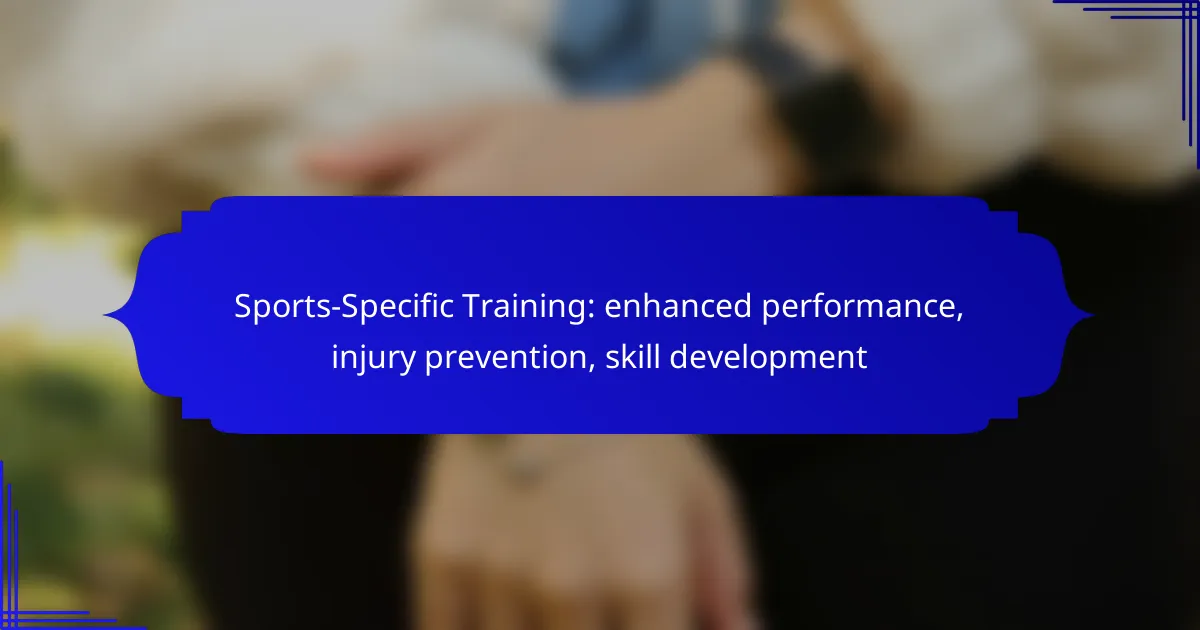Sports-specific training is essential for athletes looking to enhance their performance, prevent injuries, and develop crucial skills tailored to their sport. By focusing on the unique demands of each discipline, this training method not only boosts physical capabilities but also incorporates effective injury prevention strategies. Through targeted exercises and techniques, athletes can refine their skills in a structured way, leading to improved performance and reduced injury risk.

How can sports-specific training enhance performance in Canada?
Sports-specific training in Canada can significantly boost athletic performance by tailoring workouts to the demands of a particular sport. This approach not only improves physical capabilities but also reduces the risk of injuries associated with general training methods.
Improved strength and conditioning
Strength and conditioning are vital components of sports-specific training, focusing on the muscle groups and energy systems most relevant to an athlete’s sport. For instance, a hockey player might engage in weightlifting routines that enhance upper body strength and core stability, while a soccer player may prioritize leg strength and explosive power.
To achieve optimal results, athletes should incorporate resistance training, plyometrics, and functional movements into their routines. A well-rounded program might include exercises like squats, deadlifts, and bench presses, tailored to the athlete’s specific needs.
Increased agility and speed
Agility and speed are crucial for athletes looking to excel in their sports. Sports-specific training can enhance these attributes through drills that mimic game situations, such as shuttle runs or cone drills, which improve quick directional changes.
Incorporating sprinting techniques and agility ladders can also help athletes develop faster footwork and reaction times. For example, a basketball player might practice lateral movements and quick sprints to better navigate the court during games.
Enhanced endurance
Endurance training is essential for athletes who require sustained energy throughout their competitions. Sports-specific training programs can improve cardiovascular fitness and muscular endurance tailored to the demands of the sport.
For example, long-distance runners may focus on aerobic conditioning through steady-state runs, while football players might engage in interval training to simulate the stop-and-go nature of their sport. A balanced approach that includes both aerobic and anaerobic exercises is often the most effective.
Skill-specific drills
Skill-specific drills are designed to enhance the technical abilities required in a particular sport. These drills focus on developing the precise skills needed for success, such as shooting for basketball players or passing for soccer players.
Incorporating these drills into regular training can lead to significant improvements in performance. Athletes should aim to practice these skills consistently, ensuring they are not only physically prepared but also technically proficient in their sport.

What injury prevention strategies are effective in sports training?
Effective injury prevention strategies in sports training include dynamic warm-ups, strengthening exercises, and proper recovery techniques. These methods help athletes enhance performance while minimizing the risk of injuries during training and competition.
Dynamic warm-ups
Dynamic warm-ups involve movements that increase heart rate and improve flexibility, preparing the body for physical activity. These exercises typically include leg swings, arm circles, and high knees, which should be performed for about 10-15 minutes before training sessions.
Incorporating dynamic warm-ups can enhance muscle elasticity and joint mobility, reducing the likelihood of strains and sprains. Athletes should focus on movements specific to their sport to optimize performance and injury prevention.
Strengthening exercises
Strengthening exercises target key muscle groups to improve overall stability and support during sports activities. Resistance training, bodyweight exercises, and sport-specific drills can be effective, with sessions lasting 30-60 minutes, two to three times a week.
Focusing on core strength, leg stability, and upper body endurance can significantly reduce injury risk. Athletes should include exercises like squats, lunges, and planks, ensuring proper form to avoid overexertion or injury.
Proper recovery techniques
Proper recovery techniques are essential for allowing the body to heal and adapt after training. This includes practices such as stretching, hydration, nutrition, and adequate sleep, which should be prioritized after each training session.
Active recovery, such as light jogging or yoga, can also facilitate muscle recovery and reduce soreness. Athletes should aim for at least 7-9 hours of sleep per night and consider incorporating foam rolling or massage therapy to enhance recovery further.

How does skill development occur through targeted training?
Skill development through targeted training occurs by focusing on specific techniques and scenarios that enhance performance and reduce the risk of injury. This approach allows athletes to refine their abilities in a structured manner, leading to improved outcomes in their respective sports.
Technique refinement
Technique refinement involves breaking down complex movements into manageable components, allowing athletes to practice and perfect each part. For example, a basketball player might focus on their shooting form, working on foot placement, hand positioning, and follow-through separately before combining them into a full shot. Regular practice sessions, ideally lasting between 30 to 60 minutes, can lead to significant improvements in skill execution.
Coaches should emphasize the importance of consistency and repetition, as mastering a technique often requires numerous practice attempts. Athletes should be encouraged to set specific goals for each training session, such as achieving a certain number of successful shots or completing drills within a set timeframe.
Game scenario simulations
Game scenario simulations replicate real-game conditions to enhance decision-making and skill application under pressure. For instance, soccer players can practice set pieces or defensive formations during scrimmages that mimic actual match situations. These simulations help athletes develop tactical awareness and improve their ability to respond to dynamic game environments.
Incorporating varying levels of intensity during these simulations can further enhance skill development. Athletes should engage in both high-pressure scenarios, where they face time constraints or competitive opponents, and low-pressure situations, which allow for more focus on technique without the stress of competition.
Feedback and analysis
Feedback and analysis are crucial for effective skill development, as they provide athletes with insights into their performance. Coaches can use video analysis to highlight areas for improvement, allowing athletes to visually assess their techniques and decision-making processes. Regular feedback sessions, ideally after each training or competition, can help athletes understand their strengths and weaknesses.
Additionally, athletes should be encouraged to self-reflect on their performances, identifying what worked well and what needs adjustment. Establishing a feedback loop, where athletes receive constructive criticism and can ask questions, fosters a growth mindset and encourages continuous improvement.

What are the prerequisites for effective sports-specific training?
Effective sports-specific training requires a solid foundation in fitness and well-defined objectives. These prerequisites ensure that athletes can maximize their performance while minimizing the risk of injury.
Baseline fitness assessment
A baseline fitness assessment evaluates an athlete’s current physical condition and identifies strengths and weaknesses. This assessment often includes tests for endurance, strength, flexibility, and agility, which can vary based on the sport.
Common methods for conducting a baseline assessment include functional movement screenings, cardiovascular tests, and strength evaluations. For example, a soccer player might undergo a shuttle run to assess speed and agility, while a swimmer might focus on upper body strength tests.
Clear training goals
Establishing clear training goals is essential for guiding an athlete’s development and measuring progress. These goals should be specific, measurable, achievable, relevant, and time-bound (SMART), ensuring that they align with the athlete’s sport and personal aspirations.
For instance, a basketball player might set a goal to improve their shooting accuracy by 10% over a three-month period. Regularly reviewing and adjusting these goals based on performance and feedback can help maintain motivation and focus.

How to choose the right sports-specific training program?
Choosing the right sports-specific training program involves assessing the athlete’s unique needs based on their sport and position, as well as evaluating the qualifications of the trainer. A well-tailored program enhances performance, minimizes injury risk, and fosters skill development.
Consider athlete’s sport and position
Different sports require distinct physical skills and techniques, making it crucial to select a training program that aligns with the athlete’s specific sport and position. For instance, a soccer player may need agility and endurance training, while a football lineman might focus on strength and power.
When evaluating programs, consider the specific demands of the sport, such as speed, coordination, or flexibility. Tailored training can significantly improve performance by honing the skills that matter most for success in the athlete’s role.
Evaluate trainer qualifications
The trainer’s qualifications are vital in ensuring the effectiveness of a sports-specific training program. Look for trainers with certifications from recognized organizations, relevant experience, and a strong understanding of the sport’s demands.
Additionally, consider the trainer’s track record with athletes in similar sports and positions. A trainer who has successfully worked with athletes at the same level can provide insights and techniques that are particularly beneficial for performance enhancement and injury prevention.
